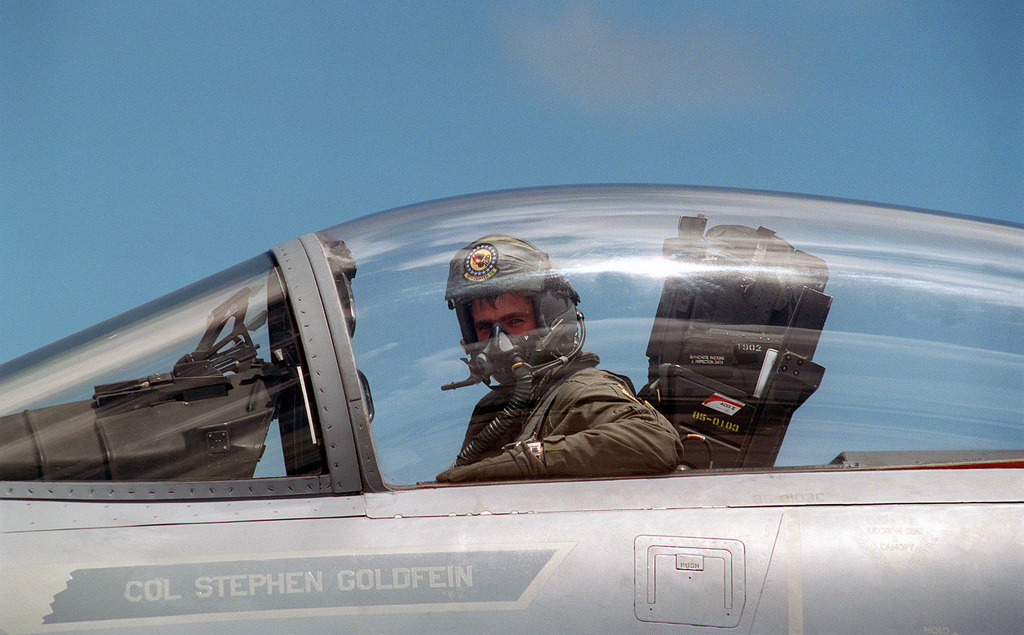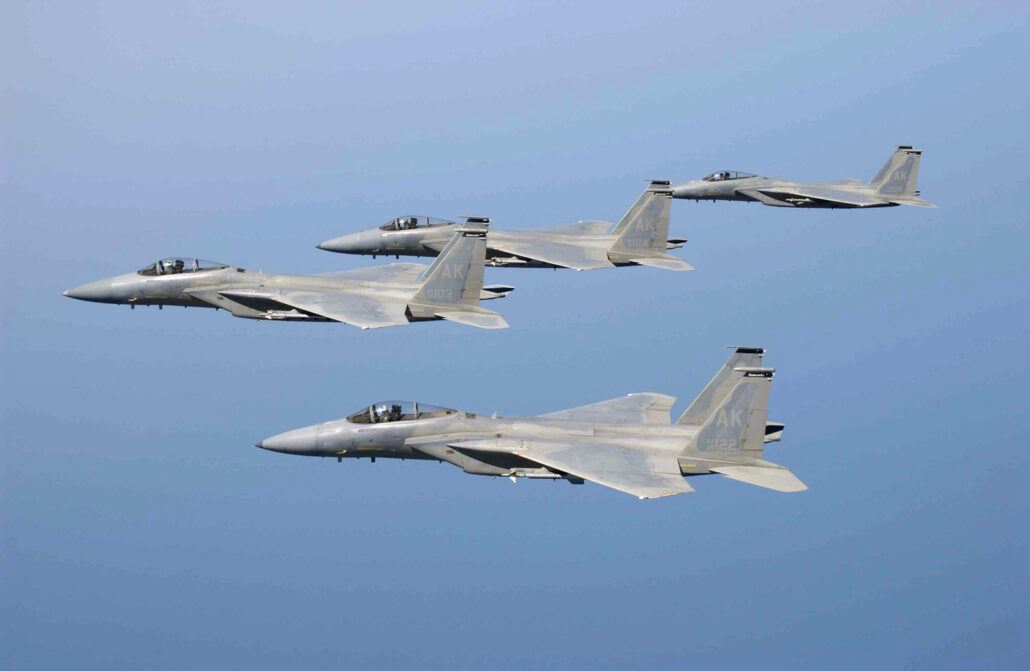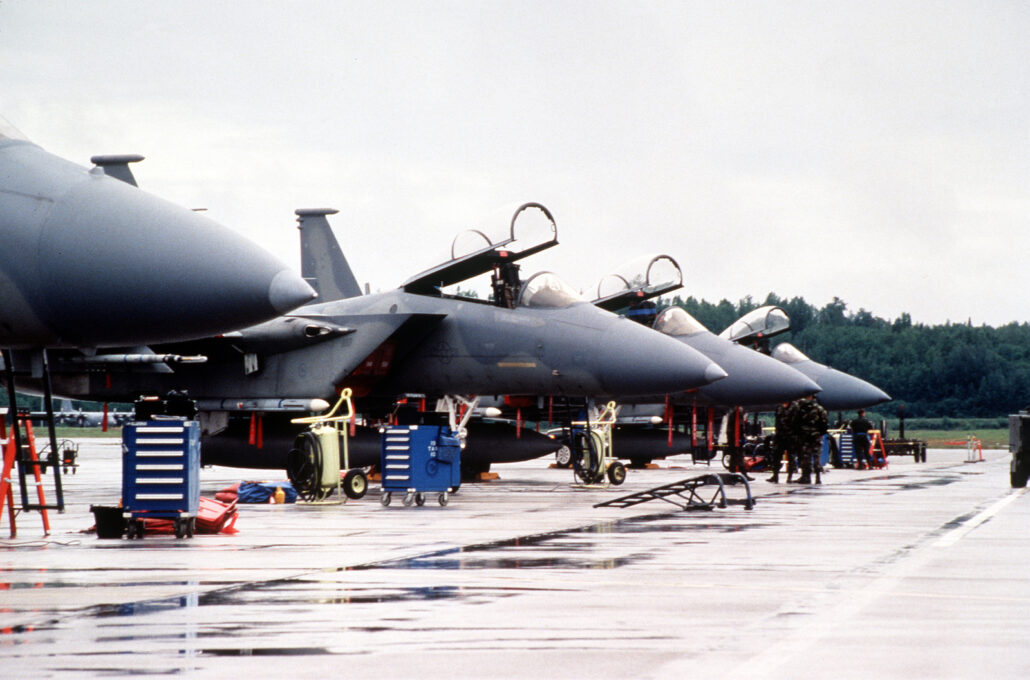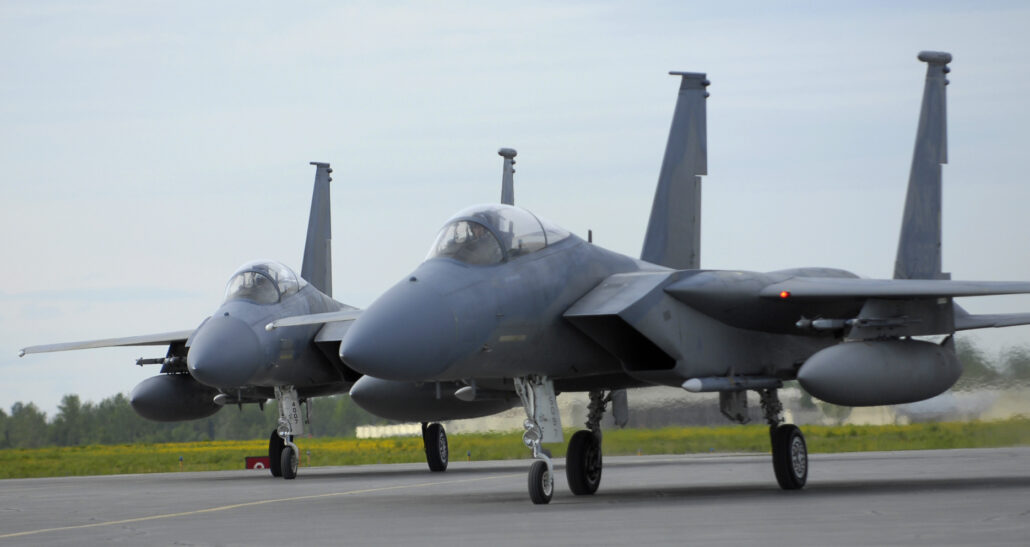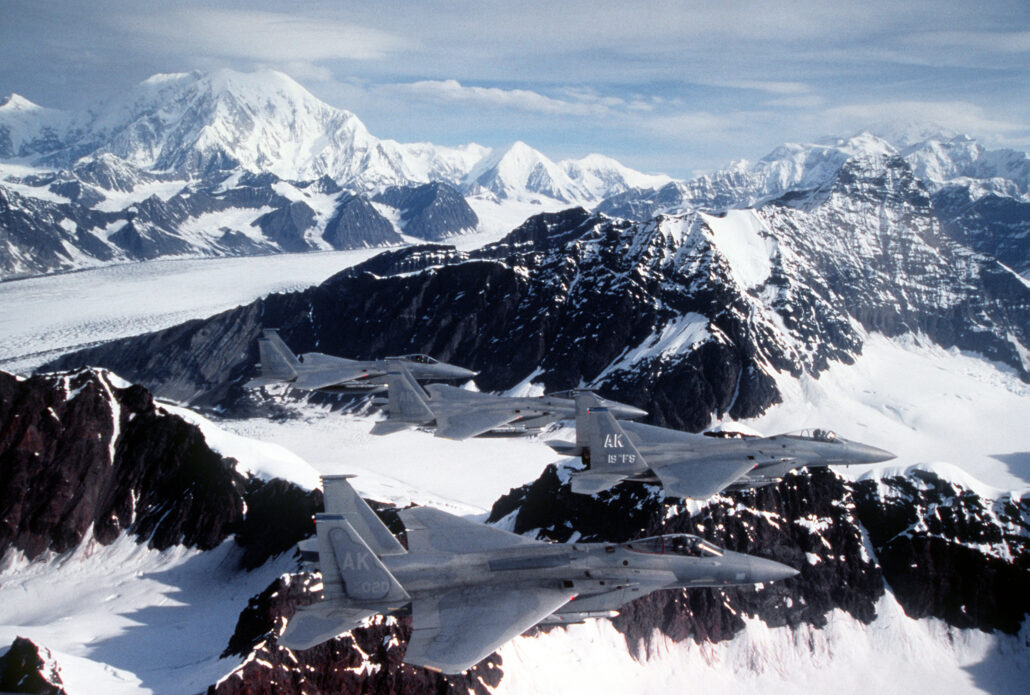Eagle History
The 19th Fighter Squadron was stationed at Elmendorf AFB, Alaska and was part of the 3rd Wing. the 19th FS operates the F-15C/D.
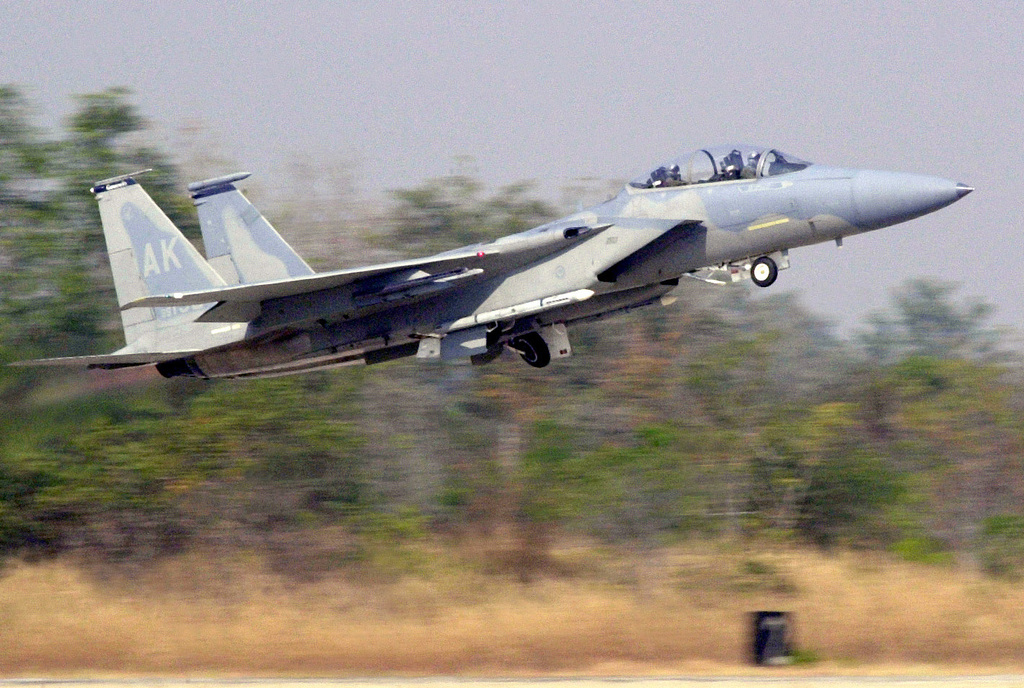
On 1 January 1994, the 19th took over personnel, facilities and equipment of 43d Fighter Squadron at Elmendorf Air Force Base, Alaska. It won the Hughes Trophy in recognition as the top air superiority squadron in the USAF for 2001. Since 1994, it has mobilized, deployed, and employed fighter aircraft worldwide to accomplish air superiority in support of warfighting commanders. The 19th will continue to provide “Top Cover for North America” into the 21st century and beyond if needed! In September of 2010 the 19th Fighter Squadron was deactivated at Elmendorf AFB, to be reactivated as a F-22 Squadron at Hickam AFB, the last F-15s departed to Barnes ANGB, to join the 131 FS.
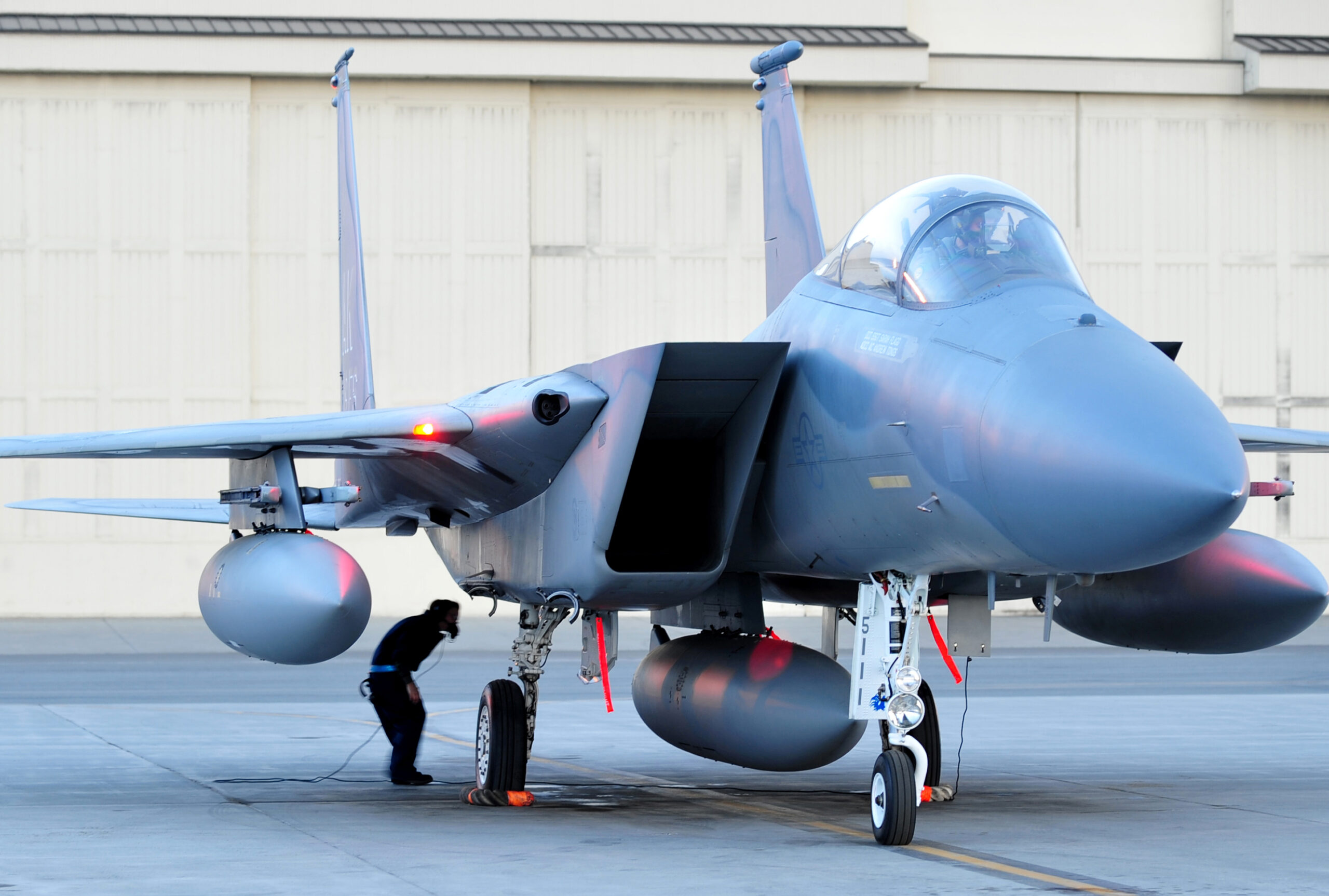
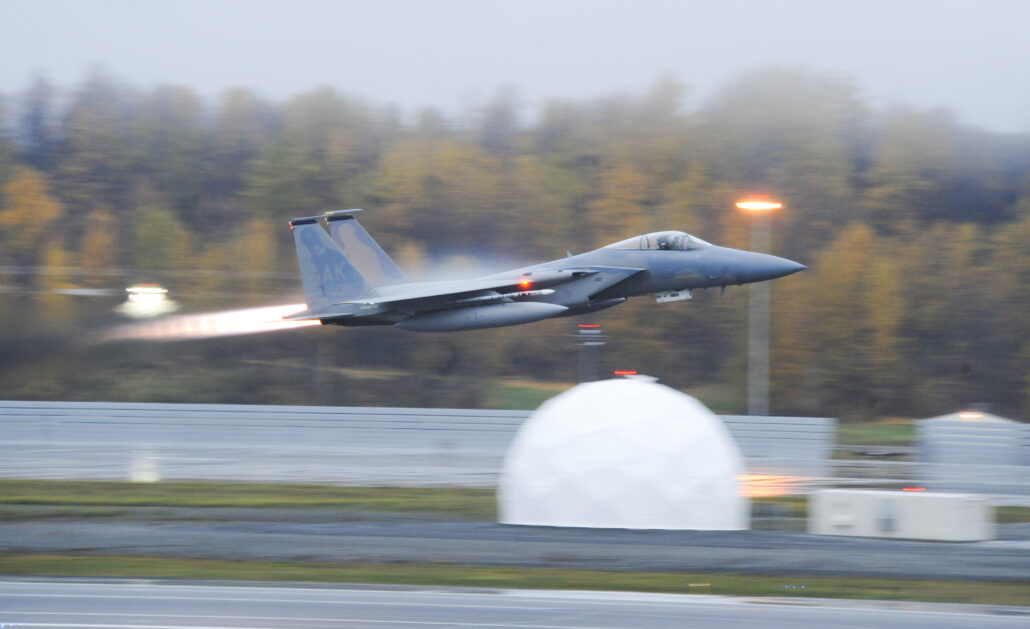
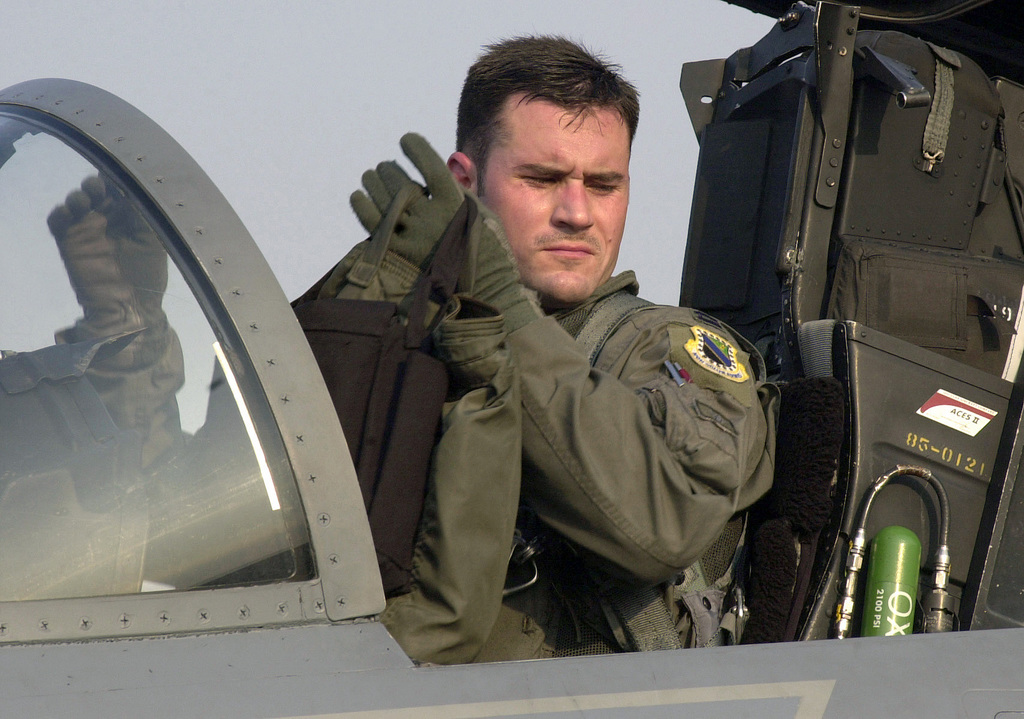
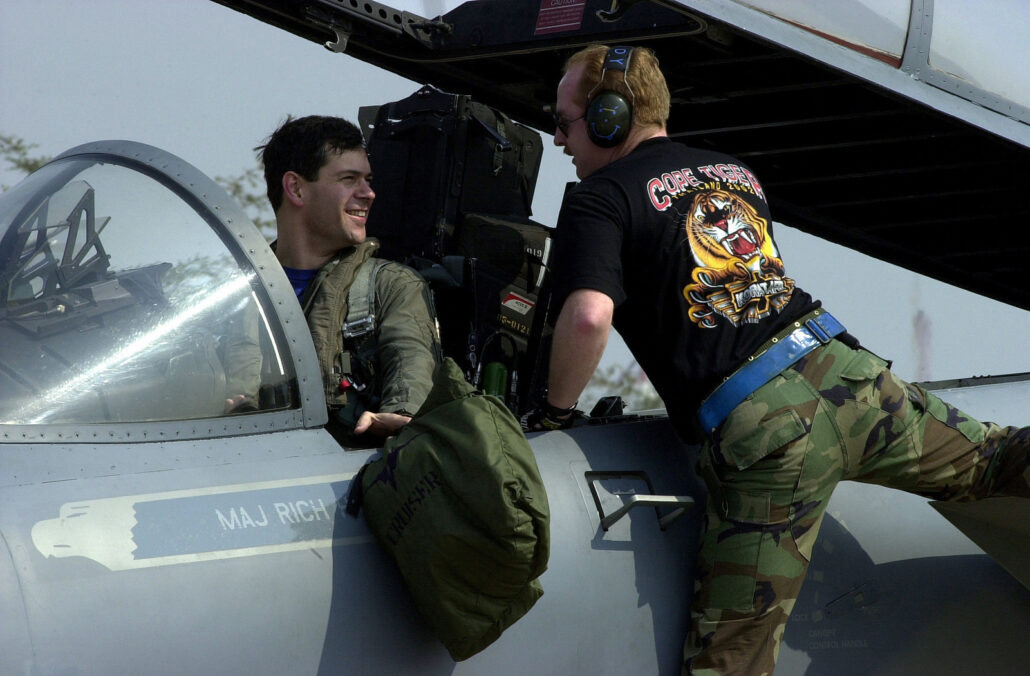
19th Fighter Squadron, F-15 Eagle, leave Elmendorf AFB behind after 16 years of service on Northern Watch
by Senior Airman Cynthia Spalding JBER PAO
9/23/2010 – JOINT BASE ELMENDORF-RICHARDSON, Alaska The last F-15D Eagle belong¬ing to the 19th Fighter Squadron flew its last flight around Alaska, Sept. 21.
Lt. Col. Brian “Barley” Bald¬win was the pilot of the fini flight for the 19th FS F-15. Baldwin flew with Senior Air¬man Michael Cowley, public af¬fairs broadcaster, to capture video footage of the last flight. “Bittersweet,” is the word Baldwin used to describe his lastF-15 flight as a part of the 19th FS in Alaska. “It was an honor to fly but sad to see it leaving Alaska,” Baldwin said.
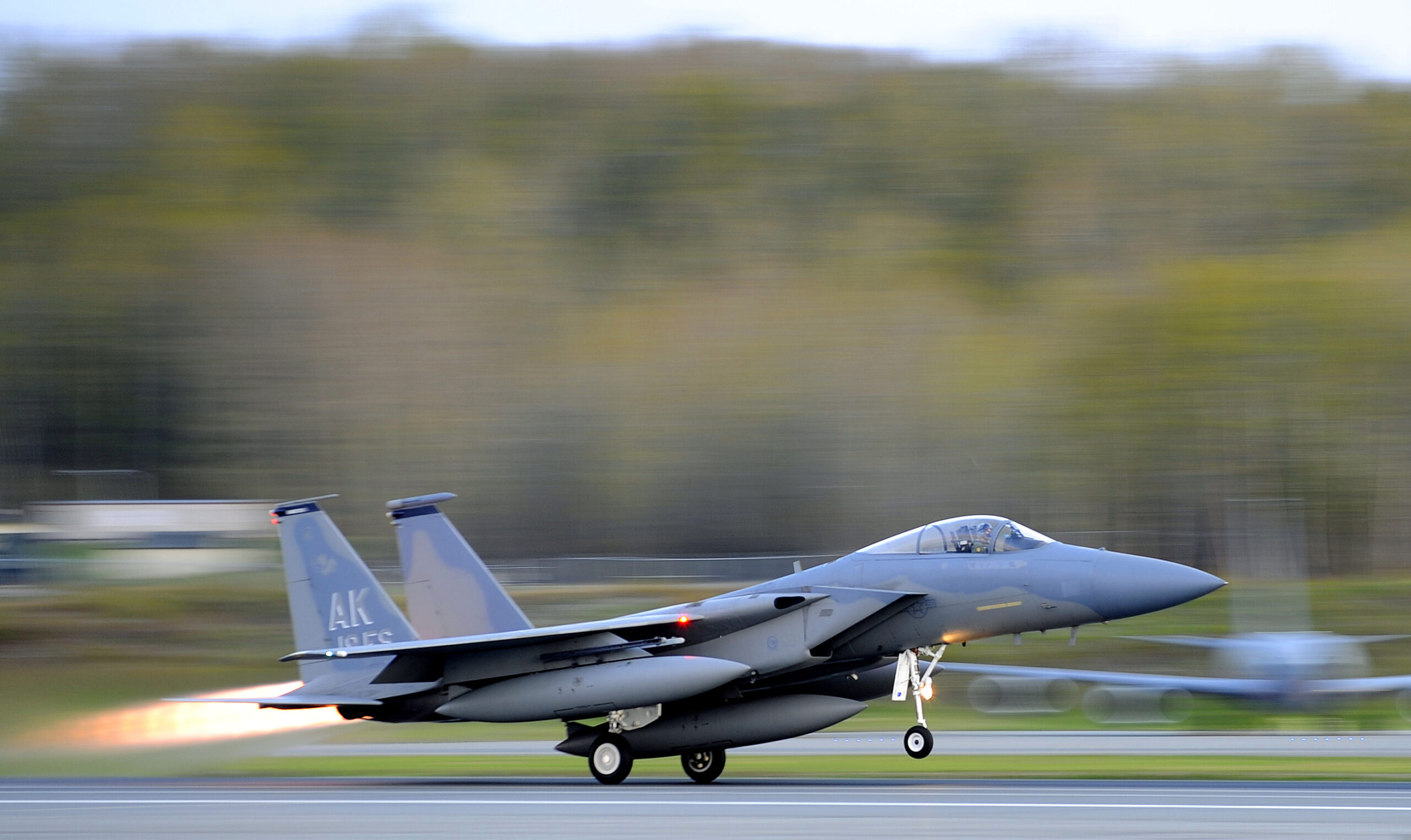
The F-15D Eagle will fly out of Alaska for good, Friday. The aircraft will be heading to Barnes Air National Guard Base, Mass., with pilots Lt. Col. Greg Miller, 19th FS commander, and Baldwin.
Baldwin will be staying with the 3rd Wing as part of the 3rd Operation Support Squadron until he leaves for Portland Air National Guard base, Oregon where he will continue to fly eagles. Miller will be heading to Joint Base Pearl Harbor-Hickam, Hawaii on October 4 to hand over the 19th FS to Lt. Col. Harvey Newton. The 19th FS will move without personnel or equipment.
19th FS wins 2009 Raytheon Trophy
by Tech. Sgt. Cohen Young Defense Media Activity-Hawaii
4/2/2010 – JOINT BASE PEARL HARBOR-HICKAM, Hawaii — The 19th Fighter Squadron recently won the 2009 Raytheon Trophy, which is awarded to the best air-to-air fighter squadron in the Air Force and is a finalist for the David Schilling Award, which is awarded to the most outstanding unit.
The 19th Fighter Squadron from Elmendorf Air Force Base, Alaska recently completed two back-to-back training exercises in Thailand and Hawaii. The squadron interacted with Thai and Singaporean Air Forces at Cope Tiger in Korat, Thailand, while also receiving vital training here with the 199th FS of the Hawaiian Air National Guard.
The training in these two places differed from what they do on a daily basis in Alaska because of weather.
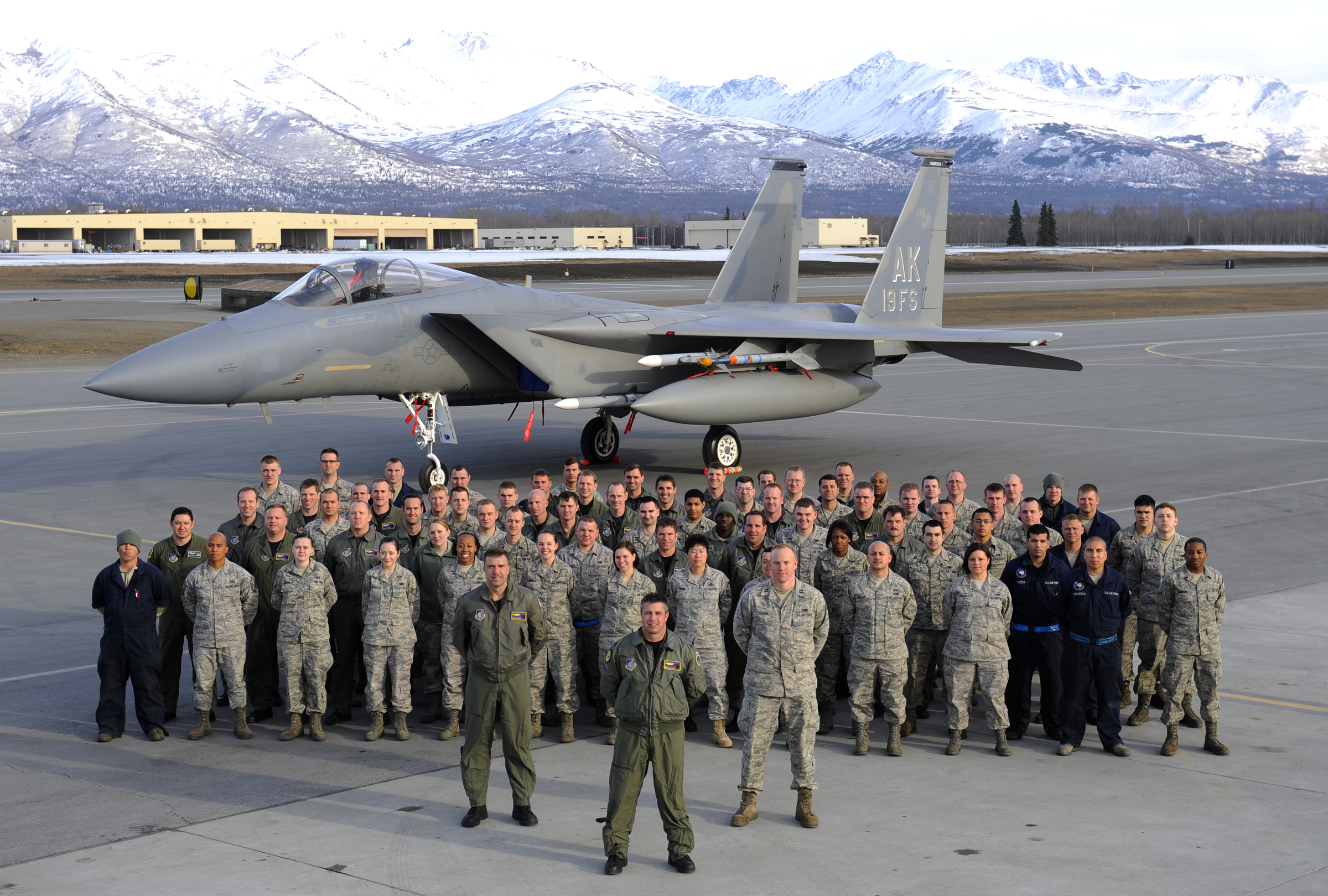
“We are able to do a lot of different things in Hawaii compared to Alaska,” said Capt. Tyler Marsh a wingman with the 19th FS. “The terrain for one is different because we fly over (Alaska) mountains daily compared to Hawaii where we can fly a 1,000 feet off the water.”
The 19th Aircraft Maintenance Unit is vital to keeping the “Gamecocks” flying in hot or cold weather conditions.
“When we’re in Alaska, our maintenance folks are out in the snow and ice all day to get our jets running, so keeping a good relationship with them is vital because we realize without them a lot of the stuff we do won’t happen,” said Captain Marsh.
Weather is a major challenge for the maintenance members in Alaska because when they have to fix something on the jet during the winter months, they have to evaluate the problem on the spot and then move the jet inside to begin work on it. This adds time to the processes.
“It’s easier to maintain the jets in Thailand and Hawaii because we can handle any problems right away without moving them inside first,” said Senior Airman Matt Pujanauski, an F-15 electrician with the 19th AMU.
Despite the challenges involved in working in the Alaskan weather, the maintainers were still able to keep the jets flying resulting in top recognition for the 19 FS.
“Being a nation at war, our Air Force is tasked at a high level, so it’s been challenging to do some of the things that we’ve done,” said Lt. Col. David Graff, 19th FS commander. “This was the last deployment for the 19th FS and 19th AMU and it has been a great year for us.”
The 19th FS is one of the squadrons closing its doors due to the fighter reduction program.
“Although it doesn’t feel good to close down a squadron, it does feel good to finish off our last full year as a Raytheon Trophy Winner,” said Lt. Col Suhr, director of operations for the 19th FS. “I’m confident that no matter where the men and women of the 19th FS and 19th AMU go, they will continue to do good things.”
Gamecocks earn PACAF nod for Raytheon Trophy
by Tech. Sgt. Francesca Popp 3rd Wing Public Affairs
1/6/2010 – ELMENDORF AIR FORCE BASE, Alaska — The 19th Fighter Squadron is ringing in another decade with an award nomination from Pacific Air Forces.
The Gamecocks are the winners of the 2009 Raytheon Award for PACAF. Gen. Gary North, PACAF commander, announced the winner in a Dec. 17 memorandum to the 3rd Wing. He wrote that while the 19th FS faced many challenges, it “showed incredible versatility that was unmatched in the command.”
The Gamecocks flew 3,602 sorties and 6,312 hours during fiscal 2009 in support of peacetime and North American Aerospace Defense Command contingency operations, while maintaining around-the-clock Response Posture Immediate alert.
“This nod is different because it recognizes not just the fighter squadron, but the entire Gamecock Team,” said Lt. Col. David Graff, 19th FS commander. “The operators would not be able to accomplish a single thing without the incredible output from the 19th AMU. I relate the successes of the Gamecock Team to the mission focused, team concept fostered by every arctic Airman. This is such an awesome honor to wrap up a great 2009 and start 2010 with this recognition.”
The 19th FS deployed to Korat Air Base, Thailand, Jan. 29-Feb. 20, 2009, for Joint Task Force Cobra Gold — a JCS-tasked combined exercise with the Royal Thai Air Force. As the lead ambassadors for the United States, they integrated eight F-15Cs with Thai air force aircraft F-16s, F-5s, A-4s, and L-39s, U.S. Marine Corps F-18s, and U.S. Army ground units. In Thailand, the squadron flew 114 hours during 93 sorties and accomplished seven upgrades; all while maintaining alert operations at home station with the impending threat of an active volcano.
Less than one month after returning, Mount Redoubt erupted and remained active for the next 99 days. Due to the eruption, the 19th FS scrambled to Eielson Air Force Base, Alaska, in the first-ever Operation Noble Eagle Flush to man the combat alert cells here and at Eielson in the event volcanic ash prevented effective alert operations from either location. The 19th FS was the first to cover both Operation Noble Eagle and Northern Sovereignty Operations alert at the Eielson CAC in more than 25 years. They maintained dual alert locations for nine consecutive days.
The Gamecocks kept hurdling all obstacles in their way. They successfully completed all Polar Force exercises and helped the 3rd Wing earn multiple “outstanding” ratings during the Operational Readiness Inspection in June. That month also marked 81 consecutive days of elevated alert status — the longest period in Alaska NORAD Region history. The 19th FS pulled 227 days of alert operations in 2009.
The Gamecocks continued this high operations tempo in spite of the Air Force announcement in May that the F-15s were being reassigned and the unit was closing.
“This dedication to our mission was amazing considering many Airmen’s futures were unknown,” said Colonel Graff.
The relationship between 19th FS and 19th AMU Airmen enabled the squadron to accomplish its robust flying training program and contingency taskings without sacrificing the health of the fleet. According to the award package, the 19th AMU had the highest F-15C mission-capable rate in PACAF, to include U.S. Air Forces Europe, with 80.9 percent. The squadron’s proactive maintenance scheduling ensured 6,668 items required by F-15 Configuration Management were also installed.
“This success is attributed to the steadfast dedication and hard work of each and every maintainer assigned to the 19th AMU,” said Capt. Adam Hauer, 19th Aircraft Maintenance Unit officer in charge. Putting this achievement into perspective, he said the Gamecocks were able to eliminate a 429 flying hour deficit in less than three months by increasing flying 25 percent. “Our unit is able to foster a strong working relationship through constant communication and dedication to one common goal.”
The squadron experienced no mishaps — aircraft losses or damage, or personnel injuries causing lost work time — in 6,312 hours of flying. The maintainers also developed a solution to prevent a critical antenna from falling off the F-15, thus directly impacting further mishaps throughout the Combat Air Forces.
“Our maintainers uphold the highest safety standards found in the Air Force with constant training and stringent use of technical orders,” said Captain Hauer. “This award encompasses the dynamic relationship of operations and maintenance. It provides a real sense of our team and how we employ day to day.”
The 19th Fighter Squadron last won this honor in 2000. The Gamecocks are 249 Airmen strong, supporting 27 F-15C/D combat-coded air superiority fighters. Their mission is to mobilize, deploy and employ the F-15C air superiority fighter in support of war-fighting commands through offensive and defensive counter air missions.
Started in 1953 by Hughes Aircraft Company, the Raytheon Trophy is given annually to the top air-superiority or air-defense squadron in the Air Force. The 19th FS is now competing at the Air Force level for this award.
Fighter Squadron completes month-long training in two continents
by Tech Sgt. Cohen A. Young Hawaii-DMA 4/2/2010 – JOINT BASE PEARL HARBOR-HICKAM, Hawaii — The 19th Fighter Squadron from Elmendorf AFB, Alaska recently completed two back-to-back training exercises in Thailand and Hawaii. The squadron interacted with Thai and Singaporean Air Forces at Cope Tiger in Korat, Thailand, while also receiving vital training here with the 199th FS of the Hawaiian Air National Guard.
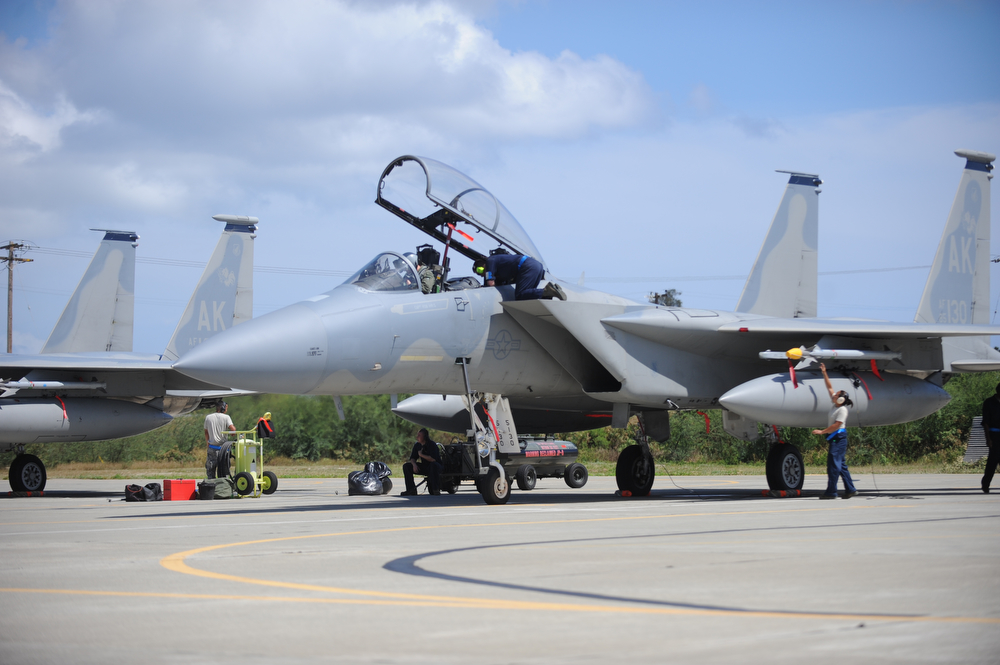
The training in these two places differed from what they do on a daily basis in Alaska because of weather.
“We are able to do a lot of different things in Hawaii compared to Alaska,” said Capt. Tyler Marsh a wingman with the 19th FS. “The terrain for one is different because we fly over mountains (Alaska) daily compared to Hawaii where we can fly a 1,000 feet off the water,”
The 19th Aircraft Maintenance Unit is depended on heavily to keep the “Gamecocks” flying in hot or cold weather conditions.
“When we’re in Alaska, our maintenance folks are out in the snow and ice all day to get out jets running, so keeping a good relationship with them is vital because we realize without them a lot of the stuff we do won’t happen,” said Captain Marsh.
Weather is a major challenge for the maintenance members when in Alaska because when they have to fix something on the jet during the winter months, they have to evaluate the problem on the spot and then move the jet inside to begin work on it. This adds time to their processes.
“It’s easier to maintain the jets in Thailand and Hawaii because we can handle any problems right away without moving them inside first,” said Senior Airman Matt Pujanauski, an F-15 electrician with the 19th AMU.
Despite the challenges involved in working in the Alaskan weather, the maintainers were still able to keep the jets flying resulting in top recognition for the 19FS.
The squadron won the 2009 Raytheon Trophy, which is awarded to the best air-to-air fighter squadron in the Air Force and is a finalist for the David Schilling Award, which is awarded to the Outstanding Unit.
“Being a nation at war, our Air Force is tasked at a high level, so it’s been challenging to do some of the things that we’ve done,” said Lt. Col. David Graff, 19th FS commander. “This was the last deployment for the 19th FS and 19th AMU and it has been a great year for us.”
The 19th FS is one of the squadrons closing its doors due to the fighter reduction program.
“Although it doesn’t feel good to close down a squadron, it does feel good to finish off our last full year as a Raytheon Trophy Winner, said Lt. Col Suhr, director of operations for the 19th FS. I’m confident that no matter where the men and women of the 19th FS and 19th AMU go, they will continue to do good things.”
